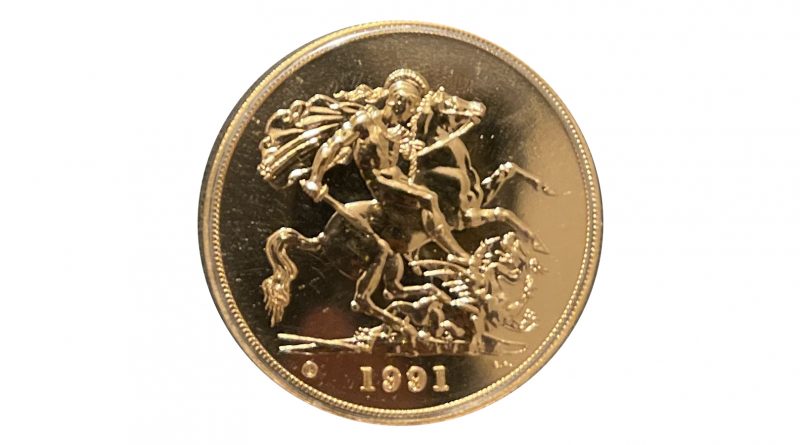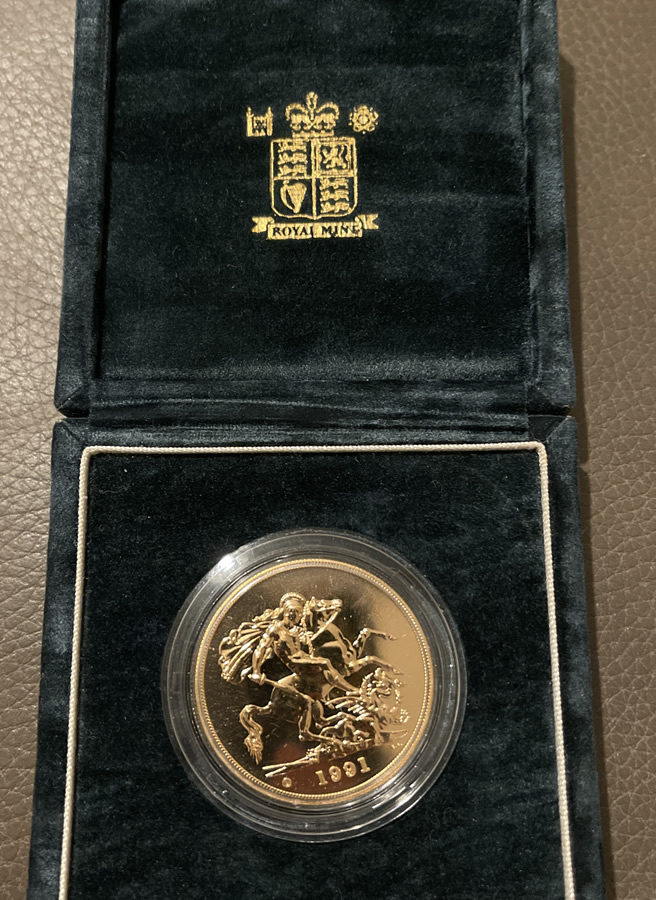Selling modern gold coins
Kieran Payne asked for a valuation on the coin pictured here. It’s not really in my line, as it is a brilliant uncirculated gold £5 piece, dated 1991 and in a presentation case. The coin was purchased from Harrods on the 31st of August 1991 for £535. Kieran still has the receipt and paperwork that came with the coin back in 1991. It was numbered 0499 of 1500 but the total mintage was only 976.
Price of gold
When it comes to the value of coins like this one much depends on the price of gold on the international market. It is priced in US$ and can go up or down. When there is a crisis of some kind somewhere in the world the price usually rises; when things are stable the price often drops.
Up to the 1960s the gold price was fixed at 35$ per ounce. The price was stable because the USA guaranteed to supply gold at that figure. However, speculators entered the market and a point was reached where the USA couldn’t afford to continue to supply gold at 35$ per ounce. Therefore, the price was allowed to float and it immediately went over the 35$ that it had previously been fixed at. Since then it has continued to rise but there have been times when it has dropped. When Gordon Brown was in charge of our finances he decided to sell our gold reserves. This was a curious move, for at the time the gold price was lower than it had been for some time.
Some people buy gold as an investment but great care needs to be taken. The international price is still fixed in US$, so buyers in the UK need to pay attention to two things: the gold price and the strength of the £. Both these factors have an impact on what profit or loss can be made.
Proof sets
When I first became really interested in coins I lived for a time in Welwyn Garden City. One of our neighbours was a bullion dealer in London and he invited me round to see some of his coins. During the course of business he had bought several sets of gold and silver coins. They included sets dated 1887, 1893, 1902 and 1911. They had originally contained £5, £2, sovereign and half sovereign but only the silver coins were still in place; all the others had been sold for their weight in gold. At the time an 1887 full proof set would have been worth around £120 but today, in mint state, the price would be around £30,000!
Don’t sell it at auction
Under no circumstances should a modern £5 piece be sold through an auctioneer. The latter might offer to sell and charge no commission. However, a buyer at auction will know about the extra premium that is added to the hammer price, so would knock that off his or her highest bid; in that case you would end up with less than the melt value of a gold coin.
Coins as an investment
Finally, unless you know the market inside out then never buy coins as an investment. This applies in particular to the ever-growing number of individual coins and sets that seem to appear on the market on an almost a daily basis. Many are worth nothing more than their weight in scrap metal. I know of people who have built up large collections, supposedly as an investment for their grandchildren. However, when the grandchildren come to sell these collections they will be lucky to receive half of what their grandparents paid for them.
Valuation
Having said all that, a 1991 brilliant uncirculated £5 piece isn’t really in my line, I did check out prices and one source had a specimen on sale at £1,800. If Kieran wanted to sell his coin then I would advise him to check prices that bullion dealers were offering for similar coins. Bullion dealers unusually work on a much narrower profit margin than coin dealers so they would be likely to offer the highest price.
Coin Valuation Service
Have your coin or artefact valued using my free online coin valuation service


